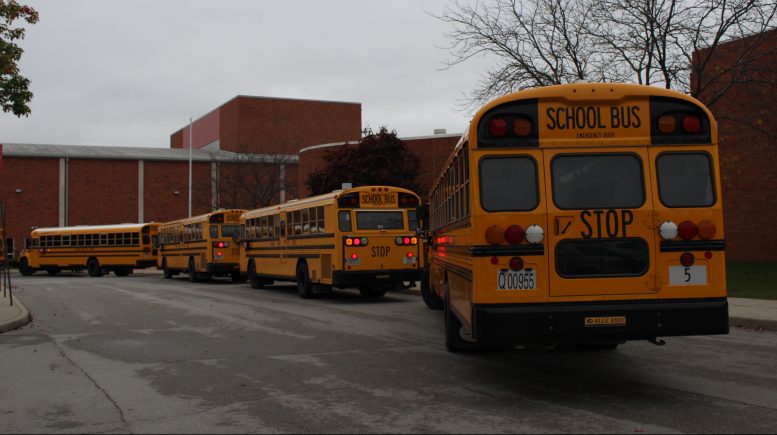By Susan Tebben
Running parallel to a House Bill in the works for years, Ohio state senators have introduced a similar proposal to equalize the public school budget formula and set up the next General Assembly with a “blueprint” for a funding overhaul.
In a virtual press conference on Friday, state Sen. Peggy Lehner, R-Kettering, and Sen. Vernon Sykes, D-Columbus, laid out Senate Bill 376, which echoes the House bill’s priorities, especially stopping an overreliance on property values to determine school district funding.
Lehner called the current funding formula “unpredictable, indecipherable and confusing,” along with “long overdue for an overhaul.”
House Rep. John Patterson, D-Jefferson, had been working with now-Speaker Bob Cupp on House Bill 305 for about three years. The original goal of the bill was to address several Ohio Supreme Court decisions, most specifically DeRolph v. Ohio, which said the public school funding formula in the state was unconstitutional, partly because the funding formula relied too much on property values.
When Cupp became speaker, the cosponsorship was moved to Rep. Gary Scherer, R-Circleville.
“It’s been well-vetted and…even in the Senate it’s not starting from scratch,” Scherer said during Friday’s press conference.
Senators joined in with a working group looking at House Bill 305 and used changes made during the process to formulate the senate bill they filed on Thursday, and plan to bring to committee this week.
What came out was a bill that uses a new ratio to decide the funding for a district: 60% based on property values and 40% based on resident incomes. The legislators say this will give the state a better idea of a district’s capacity to pay their local share.
“This is going to provide stability in that every district will be measured in the same way in determining their base capacity,” said Mike Sobul, a senior analytics advisor and consultant to the funding plan.
Sobul gave an overview of the plan for the funding formula, which he and legislators said is not meant to create concrete numbers for the next General Assembly, merely a framework for the future.
“This is really a model that is built for today’s learners to help develop Ohio’s workforce going forward,” Sobul said.
If passed, the bill would be phased in over six years, but as the Senate’s bill shows it, would focus on direct classroom instruction for 60% of the funding, followed by building leadership and operations (20%), instructional & student supports (15%) and direct leadership & accountability (5%).
Some forms of “categorical aid” would be funded immediately rather than in phases, such as funding going to economically disadvantaged areas, special and gifted education, along with preschool and English language learners.
Economically disadvantaged districts will also get help from the state to make up for any local share they might not be able to afford, under the new plan. The local share for most school districts will be between 2 and 2.5%, but those that can’t meet their local share will have the difference absorbed through state funding, according to the Senate’s plan.
As far as implementing the funding, Scherer said the state will need a total of $1.99 billion per year to make the formula work. That amount, however, isn’t far off from historic education spending, according to Scherer.
From fiscal year 2015 to fiscal year 2021, before cuts were made during the COVID-19 pandemic, Scherer said annual spending had increased $1.3 billion. From FY 2012 to FY 2019, the state saw increased spending of $2.4 billion in education.
“You can see that we’ve been able to, out of current funds, significantly increase education funds,” Scherer said.
Two of the state’s teacher’s unions say the new funding proposals are encouraging, even if it isn’t the final solution.
“For more than 20 years, Ohio lawmakers have failed to remedy the state’s harmful school funding system,” said Ohio Education Association president Scott DiMauro in a statement. “Senate Bill 376 and House Bill 305 represent an important pathway to finally address some of the greatest issues raised by that decision.”
Ohio Federation of Teachers president Melissa Cropper said the measures “represent real movement toward meeting Ohio’s constitutional requirement for an equitable and adequate school funding formula.”
The legislation does seek to address a concern Cropper said OFT members have with the funding formula, which is continued support of community and charter schools.
Through the formula proposed on Friday, the funding for students who attend community and charter schools would come through the state, and it would not be up to the local school districts to keep track of those that go there. Transportation of those students is also addressed under the new measure.
Both the House and Senate bills are ready to be considered by committees, and sponsors have hope one or both will be passed by the end of the session.
“From our very opinionated standpoint, there’s no reason that we shouldn’t be able to get this done in the lame duck,” Scherer said.
***
Also from Ohio Capital Journal:
Ohio GOP lawmakers, without evidence, cry fraud on Biden win
As a presidential election teetered toward Joe Biden, several House Republican lawmakers in Ohio took to their social media accounts to allege, without evidence, systemic voter fraud.
The state lawmakers largely parroted President Donald Trump’s speech Thursday night and subsequent campaign messaging, which alleged a wide-ranging conspiracy essentially accusing several cities of pulling Democratic votes out of thin air.
As a presidential election teetered toward Joe Biden, several House Republican lawmakers in Ohio took to their social media accounts to allege, without evidence, systemic voter fraud.
The state lawmakers largely parroted President Donald Trump’s speech Thursday night and subsequent campaign messaging, which alleged a wide-ranging conspiracy essentially accusing several cities of pulling Democratic votes out of thin air.
The reality is that many Democrats opted to vote by mail, and states like Pennsylvania have laws preventing elections officials from processing ballots before Election Day. READ MORE

